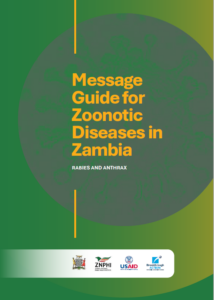This comprehensive guide supports the communication of risk and prevention strategies for zoonotic diseases in Zambia, specifically focusing on rabies and anthrax. It was developed by Zambia’s One Health Advocacy, Communication, and Training Technical Working Group, with facilitation and technical assistance from Breakthrough ACTION Zambia. The guide provides harmonized, behavior-centered messages tailored to multiple audiences, including communities, animal health professionals, and human health workers. It promotes awareness, early treatment-seeking, responsible animal care, and prevention of disease transmission through culturally relevant and actionable messages. The guide also includes cross-cutting messages applicable to a range of zoonotic threats and highlights behaviors critical to preventing future outbreaks. This resource aligns with Zambia’s National One Health Strategic Plan (2022–2026), aiming to strengthen multisectoral preparedness and response capacities.
Rabies and Anthrax Message Guide for Zoonotic Diseases in Zambia
You are here: Home1 / Resource Library2 / Rabies and Anthrax Message Guide for Zoonotic Diseases in Zambia
This website was originally developed by Breakthrough ACTION (USAID Cooperative Agreement #AID-OAA-A-17-00017) under the leadership of Johns Hopkins Center for Communication Programs. This website is now maintained by Johns Hopkins Center for Communication Programs and its contents are the sole responsibility of CCP. The contents of this website do not necessarily reflect the views of USAID, the United States Government, or Johns Hopkins University.
© Johns Hopkins University. All rights reserved.


